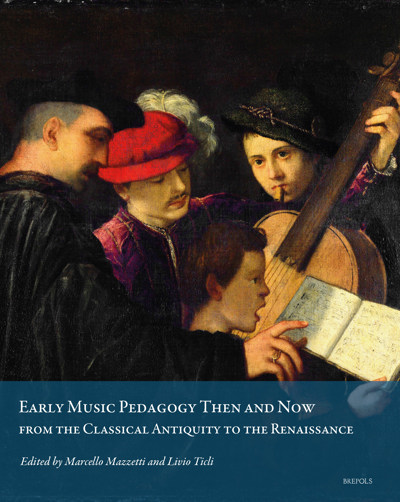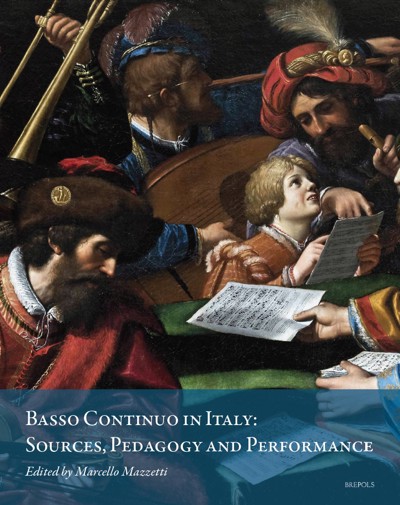
- Pages: xxx + 345 p.
- Size:210 x 270 mm
- Illustrations:30 b/w, 70 musical examples
- Language(s):English, Italian
- Publication Year:2023
- € 110,00 EXCL. VAT RETAIL PRICE
- ISBN: 978-2-503-60850-1
- Hardback
- Available
The volume explores the long-lasting phenomenon of basso continuo in the Italian peninsula
"Il quadro sin qui tracciato è impreziosito da una grande abbondanza di esempi musicali ricorrenti in tutti gli studi. Assai interessante, inoltre, è l'insieme delle porzioni di manoscritti vivaldiani (...). Da ultimo, ogniqualvolta si apre o si chiude il volume, si è portati a gettare uno sguardo alla bellissima immagine di copertina: un dettaglio del Concerto (1615 circa) di Lionello Spada nella versione conservata alla Galleria Borghese. Questa raffigurazione è stata brillantemente scelta. In essa, infatti, sono presenti i tre assi portanti del libro: sources (le parti musicali dipinte); pedagogy (il musico sulla destra che, con aria benevola, istruisce il giovane); performance (i vari strumenti musicali rappresentati e i relativi strumentisti). (Federico Terzi, in Ad Parnassum, XXII/42, 2024, p. 198)
Marcello Mazzetti is both a scholar and performer specialised in Italian Renaissance and Early Baroque Music. He is co-chair of the Istituto Italiano di Musica Antica, where he teaches Solmisation, Renaissance contrappunto alla mente and Ensemble Music, and lecturer at the University of Padua. He serves several international boards such as the "Tasso in Music Project" (UMass and Stanford University), and "Musica Incarnata" (Brepols) as a general editor.
The volume explores the long-lasting phenomenon of basso continuo in the Italian peninsula, from its origins — i.e. from the «regole per suonare sopra il basso» which collects and develops the contrappunto alla mente’s legacy — up to the late partimento pedagogy. In addition to a bibliographic update, the volume presents case studies providing the reader with new information on performative contexts and performance practice between the sixteenth and nineteenth centuries, and shedding new lights on sacred and secular genres and repertoires cultivated in churches, theatres, academies, noble chambers and domestic environments. Particular attention is given to the relationship between counterpoint, improvisation and instrumentation, to the analysis of primary sources in relation to book formats and the type of notation chosen to convey the accompaniment. Furthermore, a few chapters focus on peculiar issues of accompaniment pedagogy according to unpublished or neglected sources.
Marcello Mazzetti, Introduction
Performance Practice Issues: Stylistic Features and Historical Contexts
Naomi Matsumoto, Realising Arianna: The Problematic Accompaniments of Claudio Monteverdi’s «Lamento d’Arianna»
Galliano Ciliberti, La pratica del basso continuo a S. Luigi dei Francesi a Roma nel Seicento
Giulia Nuti, Antonio Vivaldi’s Use of Figures: «Per li coglioni» and Other Examples
Sources, Formats, and Accompaniment Layout: Stylistic Features and Historical Contexts
Augusta Campagne, Basso Continuo: The Beginnings in Italy
Thomas Neal, Between Practice and Print: Performing Palestrina’s «Missarum liber quartus» (1582) with Alessandro Nuvoloni’s «basso prencipale co’l soprano» (1610)
Marina Toffetti, Fossil Traces of Vanished Voices: The Basso Continuo Part and the Reconstruction of Incomplete Polyphony
Marcos Krieger, Figured Bass and Figured Melody: Printed Figures in Italian Continuo Sources and Idiosyncratic Continuo Notation Practices as Found in Three 17th Century Italian Prints
The Accompaniment between Pedagogy and Performance
Catherine Bahn – Giovanna Barbati, The Partimenti of Rocco Greco: Reconstructing the Pedagogical Tradition for the Early Violoncello
Peter van Tour, The Teaching of Counterpoint and Partimento in the School of Francesco Feo
Eric Boaro, Partimento Teaching at the Convent of Santi Marcellino e Festo in Naples: New Early Eighteenth-Century Sources of Realisations of Partimenti by Francesco Durante (c. 1707-1715)
Marco Pollaci, Vincenzo Bellini’s «Studio del Contrappunto» Notebook: An Investigation of a New Source of Partimento and Counterpoint in Early Nineteenth-Century Italy
Fundamental Issues: Counterpoint, Improvisation and Instrumentation
Edoardo Bellotti, Basso continuo e contrappunto nelle fonti seicentesche: un moderno approccio alla didattica musicale
Livio Ticli, «Contrapunto alla mente» or Basso Continuo? Agostino Agazzari and His «Sonare sopra'l Basso»
Abstracts and Biographies
Index of Names


